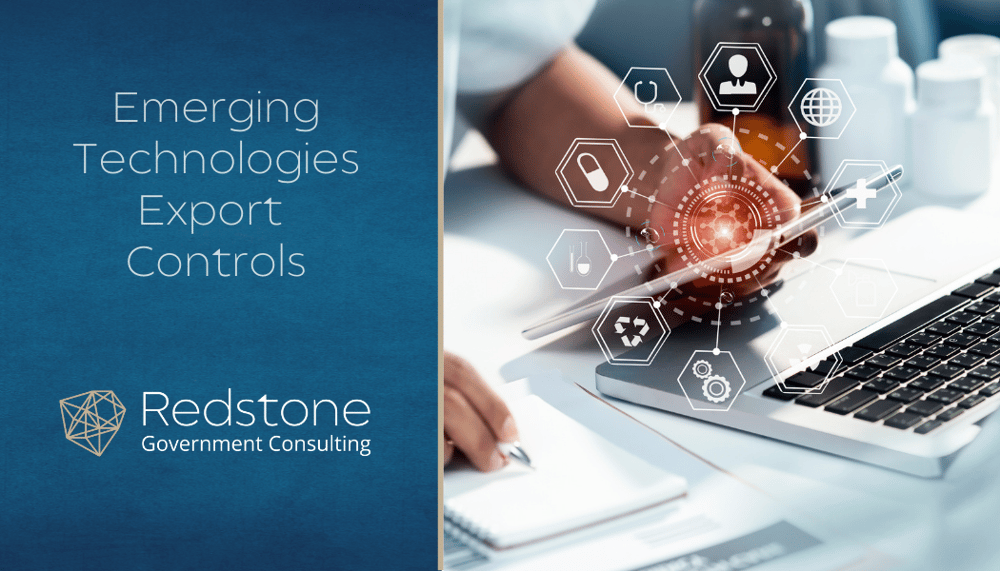
We are expecting changes this year related to Emerging Technologies Export Controls. The Bureau of Industry and Security (BIS) is holding its’ annual conference this week on Export Controls in Washington, D.C. The theme of this year’s conference is “Emerging Technologies, Strategic Trade, and Global Threats”. This event will cover:
- 5G
- Artificial Intelligence (AI)
- Emerging Technology
- The Committee on Foreign Investment in the United States (CFIUS)/ Foreign Investment
- Risk Review Modernization of 2018 (FIRRMA)
- Export Control Reform Act of 2018 (ECRA)
Due to the Export Control Reform Act of 2018, we are expecting to see new Export Control Classification Numbers (ECCNs) on the CCL for certain Emerging Technologies. As controls on exports of technology are a key component of the effort to protect sensitive U.S. technology, many sensitive technologies are listed on the CCL, often consistent with the lists maintained by the multilateral export control regimes (of which the United States is a member). Certain technologies, however, may not yet be listed on the CCL or controlled multilaterally because they are emerging.
A key focus of the new law is the protection of U.S. technological advances through closer scrutiny of technology transfers to foreign persons and their implications for U.S. national security and foreign policy.
Background-- Export Control Reform Act of 2018
As part of the National Defense Authorization Act (NDAA) for Fiscal Year 2019, Public Law No: 115-232, Congress enacted the Export Control Reform Act of 2018 (the Act or ECRA). Section 1758 of the Act authorizes Commerce to establish appropriate controls, including interim controls, on the export, reexport, or transfer (in country) of emerging and foundational technologies. Under the Act, emerging and foundational technologies are those essential to the national security of the United States and are not described in Section 721(a)(6)(A)(i)-(v) of the Defense Production Act of 1950, as amended. Emerging and foundational technologies, in keeping with ECRA, will be determined by an interagency process that will consider both public and classified information as well as information from the Emerging Technology Technical Advisory Committee and the Committee on Foreign Investment in the United States.
In identifying emerging and foundational technologies, the process must consider:
- The development of emerging and foundational technologies in foreign countries;
- The effect export controls may have on the development of such technologies in the United States; and
- The effectiveness of export controls on limiting the proliferation of emerging and foundational technologies in foreign countries.
In determining the appropriate level of export controls, the Department must consider the potential end-uses and end-users of the technology, and countries to which exports from the United States are restricted (e.g., embargoed countries). While Commerce has discretion to set the level of export controls, at a minimum it must require a license for the export of emerging and foundational technologies to countries subject to a U.S. embargo, including those subject to an arms embargo.
Representative Emerging Technology Categories
The representative general categories of technology for which Commerce currently seeks to determine whether there are specific emerging technologies that are essential to the national security of the United States include:
(1) Biotechnology, such as: Nanobiology; Synthetic biology; Genomic and genetic engineering; or Neurotech.
(2) Artificial intelligence (AI) and machine learning technology, such as: Neural networks and deep learning; Evolution and genetic computation; Reinforcement learning; Computer vision; Expert systems; Speech and audio processing; Natural language processing; Planning; Audio and video manipulation technologies; AI cloud technologies; or AI chipsets.
(3) Position, Navigation, and Timing (PNT) technology.
(4) Microprocessor technology, such as: Systems-on-Chip (SoC); or Stacked Memory on Chip.
(5) Advanced computing technology, such as Memory-centric logic.
(6) Data analytics technology, such as: Visualization; Automated analysis algorithms; or Context-aware computing.
(7) Quantum information and sensing technology, such as: Quantum computing; Quantum encryption; or Quantum sensing.
(8) Logistics technology, such as: Mobile electric power; Modeling and simulation; Total asset visibility; or Distribution-based Logistics Systems (DBLS).
(9) Additive manufacturing (e.g., 3D printing).
(10) Robotics such as: Micro-drone and micro-robotic systems; Swarming technology; Self-assembling robots; Molecular robotics; Robot compliers; or Smart Dust.
(11) Brain-computer interfaces, such as: Neural-controlled interfaces; Mind-machine interfaces; Direct neural interfaces; or Brain-machine interfaces.
(12) Hypersonics, such as: Flight control algorithms; Propulsion technologies; Thermal protection systems; or Specialized materials.
(13) Advanced Materials, such as: Adaptive camouflage; Functional textiles; or Biomaterials.
(14) Advanced surveillance technologies, such as Faceprint and voiceprint technologies.
Please keep in mind though that this information is preliminary and subject to change. To stay abreast of all the possible changes, reach out to the expert team at Redstone Government Consulting. From training opportunities to consulting packages, we offer a variety of options to inform your organization in the complicated business of government contracting.


 Carolyn Turner is an Export/Import Compliance Consultant at Redstone Government Consulting, Inc., specializing in international trade regulations, including International Traffic in Arms Regulations (ITAR) and Export Administration Regulations(EAR) on the export side. She provides guidance on import compliance matters such as customs clearance, classification, free trade agreements, country of origin requirements, duty drawback, and supply chain analysis. Carolyn advises contractors on regulatory compliance and develops policies and procedures to support effective international trade operations. Since 2002, Carolyn has held roles including International Research Analyst, International Trade Specialist, and Assistant Director or Research and Training at the Alabama International Trade Center, where she conducted market analyses, and provided training and consulting to small and medium-sized businesses across all industry sectors. She also has experience in freight forwarding working as the NVO coordinator for both imports and exports. And she has also served as an Adjunct Professor at the University of Alabama, developing and teaching online International Business courses.Carolyn is a Licensed U.S. Customs Broker and a NASBITE Certified Global Business Professional. She is proficient in Spanish. Her skills include Incoterms, import and export documentation, ITAR/EAR, free trade agreements, compliance program development, and international finance.She holds a B.S. in Commerce and Business Administration and a Master’s in Management with a Global Business Concentration from the University of Alabama. Carolyn serves on the boards of the Japan America Society of Alabama, Destination Hoover International, and BIO Alabama, and is a member of the Export Alabama Alliance.
Carolyn Turner is an Export/Import Compliance Consultant at Redstone Government Consulting, Inc., specializing in international trade regulations, including International Traffic in Arms Regulations (ITAR) and Export Administration Regulations(EAR) on the export side. She provides guidance on import compliance matters such as customs clearance, classification, free trade agreements, country of origin requirements, duty drawback, and supply chain analysis. Carolyn advises contractors on regulatory compliance and develops policies and procedures to support effective international trade operations. Since 2002, Carolyn has held roles including International Research Analyst, International Trade Specialist, and Assistant Director or Research and Training at the Alabama International Trade Center, where she conducted market analyses, and provided training and consulting to small and medium-sized businesses across all industry sectors. She also has experience in freight forwarding working as the NVO coordinator for both imports and exports. And she has also served as an Adjunct Professor at the University of Alabama, developing and teaching online International Business courses.Carolyn is a Licensed U.S. Customs Broker and a NASBITE Certified Global Business Professional. She is proficient in Spanish. Her skills include Incoterms, import and export documentation, ITAR/EAR, free trade agreements, compliance program development, and international finance.She holds a B.S. in Commerce and Business Administration and a Master’s in Management with a Global Business Concentration from the University of Alabama. Carolyn serves on the boards of the Japan America Society of Alabama, Destination Hoover International, and BIO Alabama, and is a member of the Export Alabama Alliance.